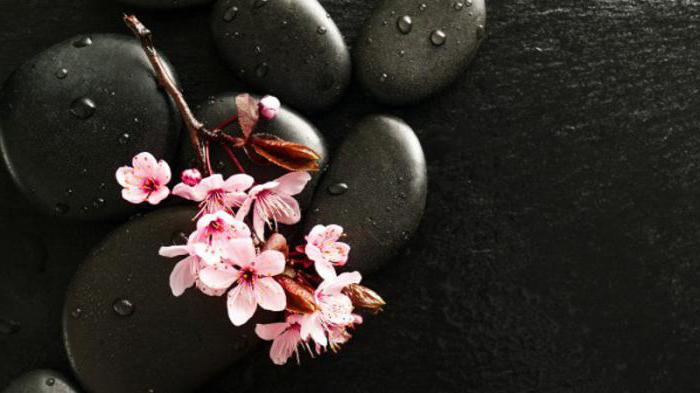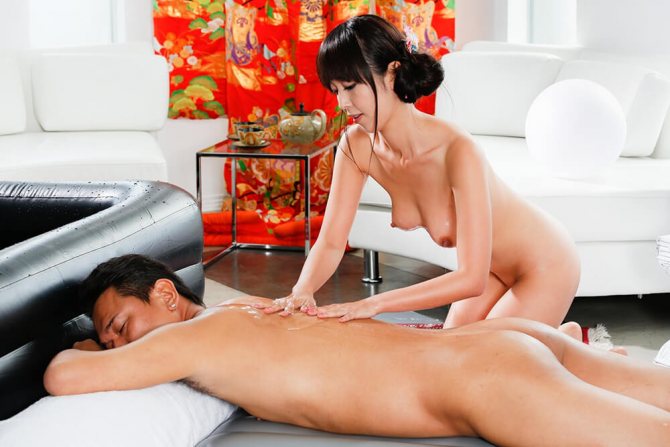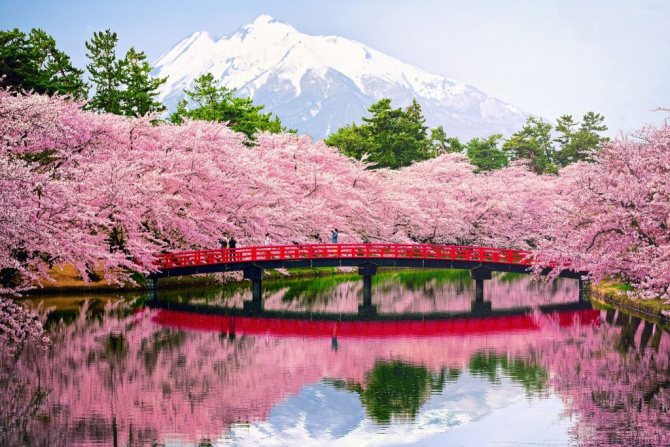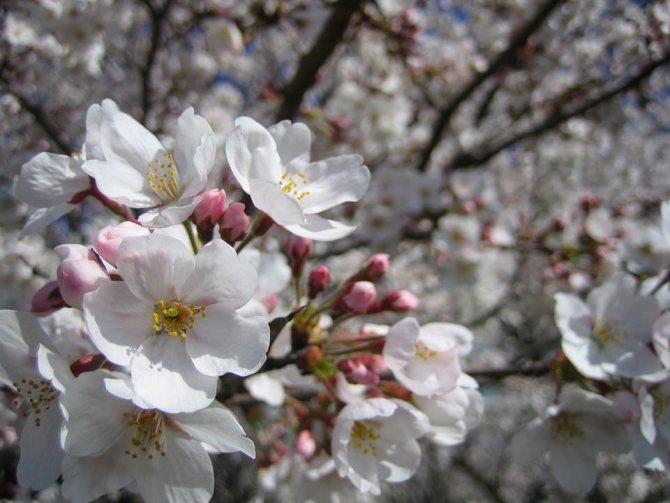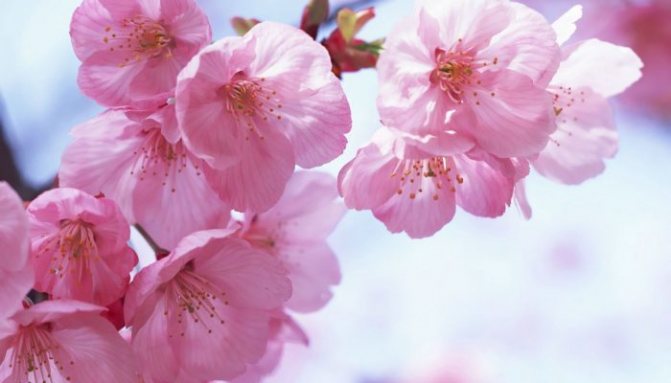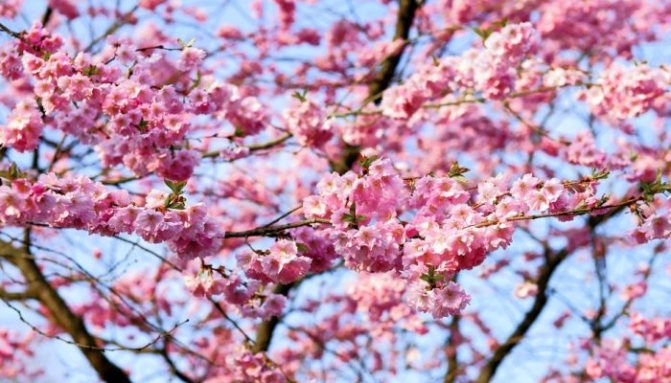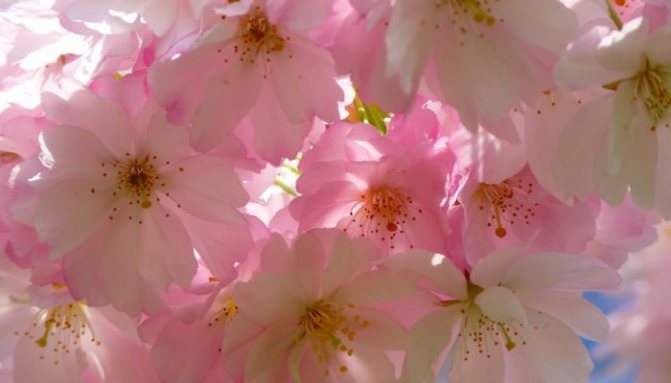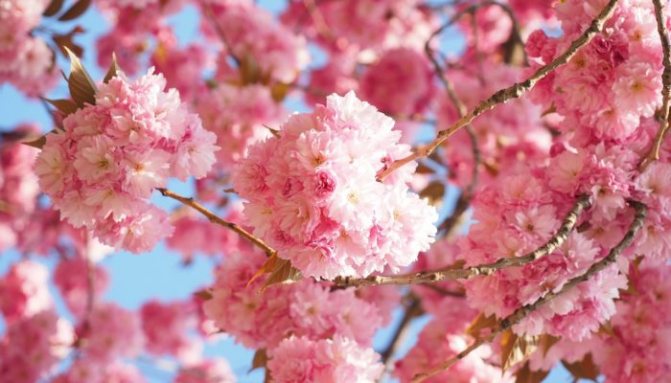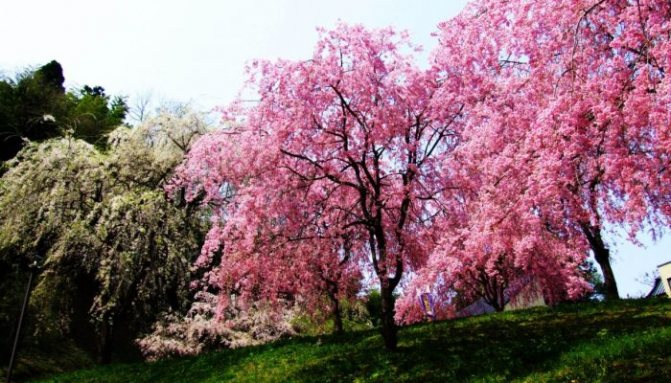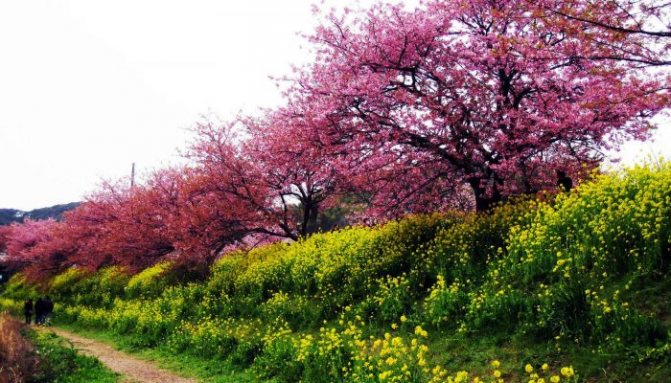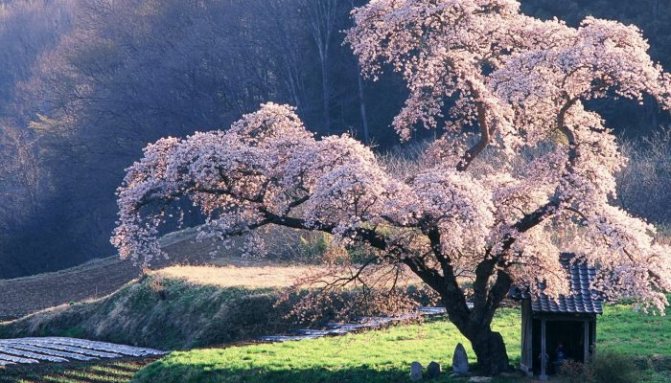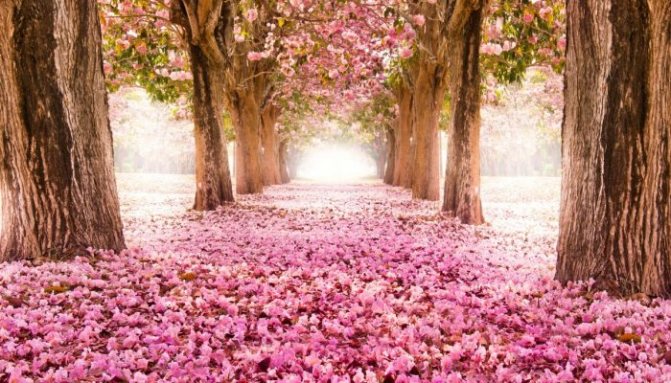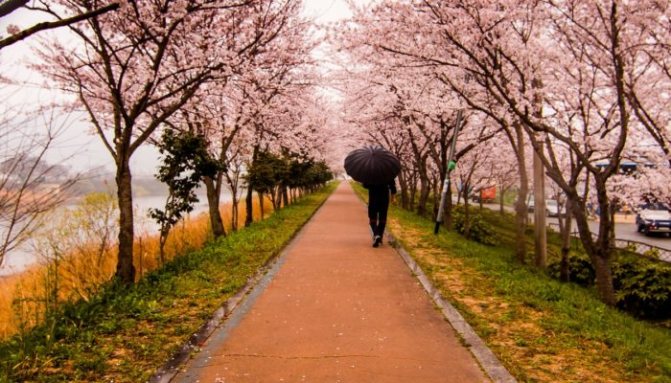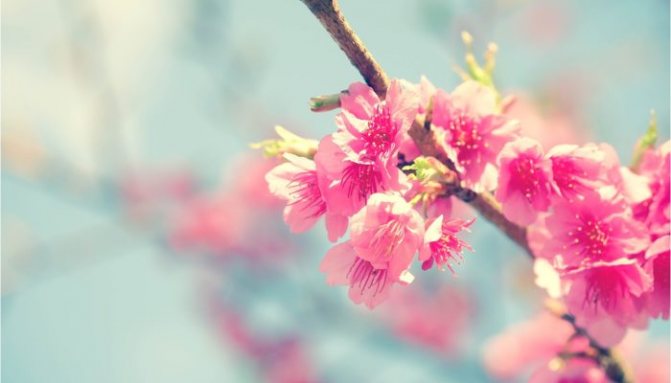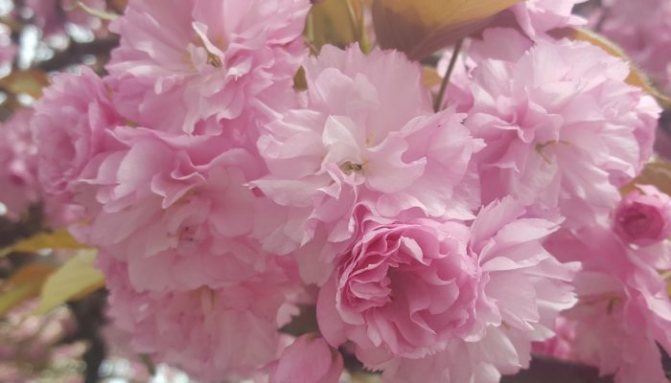Sakura in feng shui
In Japan, the sakura is a very significant symbol, it represents all the most beautiful that can be found in this world. The delicate blossoms of the oriental cherry tree are associated with female beauty, love, the birth of children, renewal and rebirth.
- Feng Shui cherry trees are a talisman that brings happiness, harmony and prosperity, and its five petals, gathered in a bud, are a sign of unity of spiritual and carnal joys.
Meaning of the Cherry Tree in Eastern Culture
A beautiful legend
A beautiful Japanese legend tells of the God of Heaven, who decided to take as his wife one of the daughters of the Earth God. The older girl was as sturdy as a rock, and the younger was as beautiful as a wild cherry blossom. It is clear that the groom did not hesitate to choose the second one, but in doing so he offended his loving father. As a result, he agreed to the marriage, but put a spell on all the offspring of the couple:
- Henceforth, people's lives are full of light emotions, but short-lived - like cherry blossoms that are plucked from the branches by a careless breeze.
Symbol of the transience of life
In modern tradition the cherry tree is a symbol of the transience of life. In the spring wild cherry blossoms remind people that happiness, youth and love can not last forever, so we need to enjoy every minute.
- To keep this in mind, Japan annually celebrates Hanami, a special holiday that consists of admiring cherry orchards, meditating and reflecting on eternity.
What does feng shui mean by a cherry tree in the house?
Who is it good for?
For the residents of the Land of the Rising Sun, cherry blossoms are a very nice and symbolic gift, and its presentation is a wish for prosperity, longevity and peace. Such gifts are especially in demand at weddings, they are often brought to young spouses to emphasize their respect and deep friendly feelings.
- Directly for the couple to plant a sakura in the yard - an auspicious omen, promising a life of harmony and love.
Where to place?
Since it is not so easy to grow a sakura in a normal modern apartment, you can get by with its symbolic image: embroidery, a photo, a picture.
- According to feng shui, place such a talisman should be in the Southwest, in the Marriage Zone.
In this case, it will act as an activator of the Love Sector - will help build a harmonious union based on trust, to preserve for many years of passion and romance.
Artificial Tree
The century of fresh flowers is short, so artificial sakura at home is quite appropriate - a small souvenir tree is convenient to keep on the dressing table or on the bedside table. A great option to add a little oriental sophistication to the bedroom interior and give yourself a great talisman that helps to strengthen family relationships.
Meaning for men
Tattoos with sakura are also nabbed by members of the stronger sex, despite the delicacy of the flower. For men, the sakura symbolizes strength and endurance. Elegant flowers or twigs are intertwined in an ensemble with other Japanese motifs. Such men are followers of Japanese philosophy and cultivate a pragmatic approach to life. The transience of life and the cyclical nature of existence does not scare them. The most important goal is to leave their mark. Spiritual integrity and the desire for new things, means sakura on a man's body.
Why is the sakura a symbol of Japan?
The sakura, or Japanese cherry tree, is one of Japan's most famous symbols. When the Land of the Rising Sun is mentioned, the association with a flowering ornamental plant of the plum family, covered with a cloud of white-pink petals, always comes to mind. The name "sakura" comes from the word "saku", which means "to bloom" and the plural ending "-ra". The ornamental plant blooms from late March to early April. During the rest of the seasons, the trees are only covered with a crown of leaves, which fall off by winter.
The brief but magnificent season figuratively represents human life, when bloom is inevitably followed by fading and death. The days of the vernal equinox, when the cherry trees bloom, are a time of religious festivals with rituals of supplication for a good harvest. In this sense, the cherry blossom is a symbol of prosperity and good fortune.
Another symbolic meaning is the expression of the connection between people, the representation of such different concepts as courage, sadness and happiness. Cherry blossoms in Japanese culture are a manifestation of pure beauty. In addition, the sakura is a metaphor for the fact that nothing is eternal in this life. The theme of all that is transient, changing in the world, is central to the Buddhist religion.
The cherry blossom season coincides with the beginning of the Japanese Old New Year, which until 1873 was celebrated according to the lunar calendar and fell at the beginning of spring. Hence, in the minds of the Japanese there is a strong association with the beginning of something new, which is awaited with enthusiasm and optimism. In different historical periods the sakura flower symbolized Japanese nationalism and militarism.
In Bushido, the code of the samurai, the sakura was chosen as the emblem symbolizing the feat of a warrior who gave his life for the emperor. The samurai tattooed cherry blossoms as a reminder of the transience of life, when every day can be the last, so you should appreciate every moment and rejoice in every manifestation of beauty.
During World War II, these flowers were painted on kamikaze planes. Also in national aesthetics, sakura blossoms represent the beauty and sexuality of a woman, her ability to control her emotions and dominate men. In the language of flowers, a cherry blossom also means love and passion. Another meaning given to the delicate flower is innocence, simplicity and spring purity:
"At the time of blossoming, Cherries are akin to clouds - Is that not why the soul has become more spacious, Like the springtime sky..." (Kamo Mabouti)
The color of the petals depends on the subspecies, there are white, pinkish and deep pink, scarlet, yellow, pale green shades. In Japan, a spectacular national festival "hanami" is held in honor of the beloved tree. Relatives and friends gather for a picnic in cherry parks under the shade of fragrant branches, where they celebrate the beginning of the flowering season. Cherry blossoms have been used to decorate clothing (kimono), letterpress paper, notebook covers, and household items, including kitchenware.
For centuries, the blooming sakura has inspired Japanese artists, who included the sakura as a landscape decoration in fine prints. The cult of the ornamental cherry has adapted in other cultures as well. In several countries, the tree is planted to beautify streets and parks. Since 1912, an annual Cherry Blossom Festival has been held in Washington, D.C.
Features
Only women with perfect and well-groomed bodies and impeccable technique are allowed in the salons. The masseuse's body is the main tool in this type of massage. Legs, bikini area and armpits should be as smooth as possible. In addition, there should be no rough skin on the body, this applies to the knees, feet, elbows and palms. Women with long and sharp manicures and piercings are not allowed to the procedure.
The masseuse completely undresses and removes her jewelry. The main thing in this massage is not to cause unpleasant feelings to a client or a partner. Before the procedure, the girl applies fragrant oil on her body, providing a pleasant smell and glide. This also aggravates the tactile sensations.
Why is the sakura a symbol of Japan
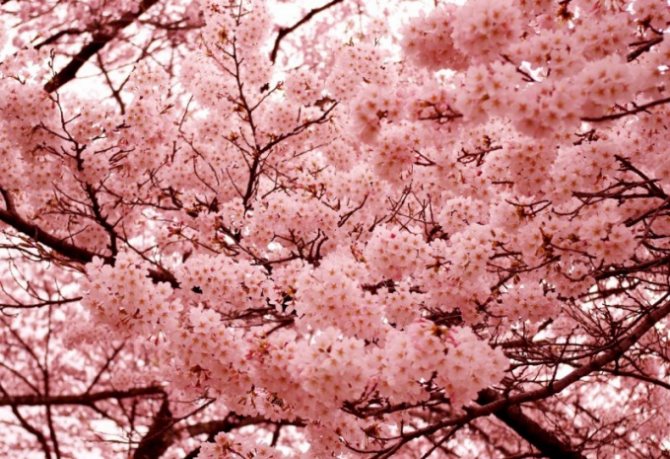
- Why is the sakura a symbol of Japan?
- How Cherry Blossoms
- How Cherry Blossoms Look Like in 2021
For the Japanese, the blossoming of the sakura is a national holiday. Weather forecasters predict the expected blossom time in advance. Television and radio news report about the start of blossoming in every district and most famous parks. The number and species of trees are always listed.
In ancient times, people of all walks of life, such as aristocrats, samurai, and peasants, were seated on the ground. In ancient times, people of all estates - aristocrats, samurai and peasants - were seated on the ground beneath the trees. In the enterprises of modern Japan, a special day is chosen when the entire team goes to the park to admire the delicate blossoms of the sakura. It is believed that the blooming cherry blossoms endow their guests with wisdom and divine beauty.
Hanami is considered a special celebration at night, when the soft light of small lanterns suspended under the tree crowns and the glow of tall lanterns turn the gardens of blossoming cherry blossoms into a truly heavenly garden - quiet, warm and divinely beautiful.
The history of ancient festivals is usually associated with mythology. One of the most tragic Japanese legends is about cherry blossoms. A Japanese village was once ruled by the cruel Prince Hotta, who ordered that not only the peasants but also their families be tortured for the slightest disobedience. Wanting to end Hotta's atrocities, the village elder, whose name was Sakura (the Japanese word for "sakura" is masculine), showed the Shogun the whipped backs of his children.
The shocked ruler gave orders to punish Hotta. But Hotta did not forgive the offence: he seized Sakura along with the children, tied them to a tree, and flogged them to death. When the sakura flowers, normally white in color, bloomed the following spring, people were stunned. The flowers turned pink, as if the blood of innocent children had stained them.
Unfortunately, cherry blossoms are short-lived: they last just over a week. Therefore, its flowers are considered a symbol of the fleetingness of life. Some Japanese, wishing to prolong their favorite holiday, follow the sakura from city to city. If you follow it from the beginning of flowering in the south to the fall of the last petals in the north, you can admire it for a month. Interestingly, the flowers first appear on the branches of the sakura, and only after they have fallen do the leaves blossom. Therefore, the blooming tree stands entirely in white or pink color.
Since ancient times, the sakura has been a source of inspiration for poets and artists. Modern plant breeders are no less interested in it. Today there are over 300 varieties of cherry trees in Japan, many of which are created by crossing long-known varieties.
Hanami Festival
One of the most important events for the Japanese is the Hanami Festival, a celebration of cherry blossoms. Not without reason the cherry tree is a symbol of feminine beauty according to Feng Shui, because the pink tree is admired by day and night. In a calm and peaceful environment, the Japanese and tourists think about eternal, the transience of life. The process of admiring cherry blossoms is called o-hanami.
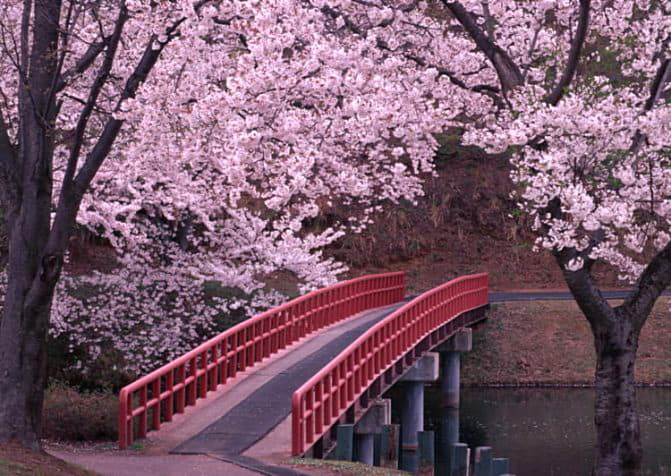

The tradition itself originated in the era of the Heian imperial dynasty. The wealthy spent a great deal of time under the cherry blossoms, seeing the deep meaning in the blossoms. The flowers falling to the ground were a reminder of the rapid flow of life and symbolized courage and clarity of thought.
The sakura is a symbol of Japan
For centuries the cherry blossom has been a favorite of the inhabitants of the Land of the Rising Sun and has become a symbol of Japanese character. However, this love is due to more than just traditional affection. "In its beauty and elegance, on which the aesthetic principles of our culture are based, no other flower in the world can compare to it," wrote Inadzo Nitobe (1862-1933) in his famous book Bushido (The Way of the Samurai), published in 1900. Spring in Japan is primarily associated with the cherry blossom season. This season begins not when flowers appear on individual trees, but when the entire country is transformed into a magical garden of white-pink flowers. At the end of March, as the last winter chills subside, a wave of cherry blossoms sweeps over all the Japanese islands. The blooming begins in southern Kyushu, then reaches Tokyo in early April and covers Hokkaido by mid-May. This year, though, the cherry blossoms will come earlier than usual.
"Hanami," admiring the cherry blossoms, is a favorite Japanese tradition. But even though "hanami" literally translates to "admiring the flowers," it is just as firmly associated with a good snack and a drink at a picnic with family or friends under the blossoming trees. According to historians, the tradition of admiring sakura blossoms originated at the imperial court in Kyoto during the Heian period (794-1185). Before this period, however, connoisseurs were more partial to the flowering plum ("umae"), whose trees had been brought to Japan from China and were considered a symbol of foreign culture. When, in 894, the practice of sending envoys to China was abolished, the imperial court began to appreciate its own culture and traditions more. Thus, over time, the sakura flower became more popular in Japan. Admiring the cherry blossoms became part of the list of official festivals and ceremonies. One of the most famous "hanami" was held in 1598 by the military leader Toyotomi Hideyoshi. After achieving complete victory over the separatist princes and taking control of the entire country, Hideyoshi led a procession of 1,300 people to the Daigo Shrine in Kyoto, where a celebration of the cherry blossoms took place. This event became a favorite subject of numerous poems and productions of the Noh theater. In the next century, the common people began to increasingly share the love of the "hanami" of their lords. During the Tokugawa shogunate (1603-1867), many sakura trees were brought from Mount Yoshino (Nara Prefecture) to Edo to decorate the country's new political center. Thanks to the sankin kotei system established by the shogun, under which every Japanese feudal lord was required to live in Edo for at least a year, large numbers of sakura trees were shipped to the capital from all over the country in supply convoys. At this time new varieties of trees also appeared, which were bred as a result of both natural and artificial crossbreeding. Now there are more than 300 species of sakura in Japan, although no more than 10 species are natural.
But why has the sakura flower maintained its popularity for such a long time? It is said that the fleeting nature of cherry blossoms, lasting only a few days, best suits the characteristics of the Japanese character. And the tradition of picnicking under blossoming trees is linked to the ancient belief that flower pollen dropped into a cup of sake gives strength and health. Cherry blossoms have also been a favorite subject of many famous artists. They appear in countless paintings, poems, and later photographs and movies, not to mention that the sakura is the most popular ornament of women's kimonos. Many stores and department stores are now decorated with cherry blossoms, but it looks less romantic because the flowers are mostly made of plastic. Products and drinks available only during the cherry blossom season appear on the shelves. The most famous of these are "sakura tya," tea with salted sakura petals, and "sakura moti," pastries made of sticky rice and filled with sweet red beans wrapped in a salted sakura leaf. Every store also offers a "hanami bento," a picnic box with various snacks, desserts, and cocktails. But not only the Japanese appreciate the beauty of cherry blossoms. Anyone visiting Japan at this time will be thrilled to see the blossoming trees fluttering in the wind ("hanafubuki"), as well as cherry blossoms by moonlight or paper lanterns ("yozakura"). It is an experience that will remain in your memory for years to come. Although there are many famous places to admire cherry blossoms in every area, everyone follows radio and television reports closely to see where the most beautiful blossoms can be seen at a given moment. In Tokyo, the cherry blossoms usually bloom in April, and it is impossible to miss this season. One of the most famous "hanami" sites in Tokyo is Shinjukugyeon National Park, which has 1,500 sakura trees of 75 species. It is followed by Ueno Park, the largest urban park in Tokyo with an area of 626,000 square meters and 1,100 trees. From the end of March until early April, the city's festival will be held here to celebrate the cherry blossom season. No less famous is Sumida Park, which has about 400 trees and under them installed a unique lighting.
Performance technique
What is the "Cherry Blossom Branch"? It is not just an erotic massage. If it is performed professionally, it can not only improve the mood, but also strengthen the body. There is a huge variety of techniques for performing the "Cherry Branch". The main condition for a proper massage is to feel the partner, his desires, to catch the mood, that is to become for a while him, to feel the same as a man. The main condition in the technique is speed. All the movements of a woman should be set to a tempo. If it is slow, the man relaxes, if it is fast, he gets excited. When the tempo is alternating, the massage gives special pleasure.
Another important factor in the technique "Sakura branches" is the pressure on the partner's body. The less it is, the more relaxed the man is. Gradual increase in pressure relieves fatigue in the body and muscles. In a good massage the movements should be continuous, i.e. during the session the masseuse constantly touches the partner. Usually the procedure begins with a light stroking of the head, neck. If the man lies on his back, then the face. During the session the masseuse goes gradually lower, but does not immediately begin with the intimate area. Enhances the effect of massage and breathing. Of course, the woman must be pleasant and fresh smelling.


Sakura - the symbol of Japan
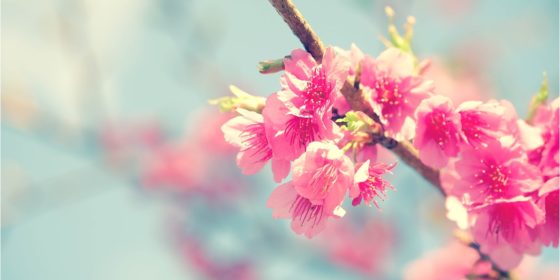

When the god of the mountains asked Ninigi, the grandson of the sun goddess, to marry one of his daughters, he decided that if he preferred the eldest, the High Rock, their descendants' lives would be as enduring and solid as rocks. But if he preferred the younger one, the Blossom, then the lives of their children, regardless of their social status, would be as beautiful but as short as the blossom of a sakura tree. Ninigi chose Blossom and became the ancestor of Japanese emperors.
The Japanese, annually contemplating the beauty of this amazing plant and looking at the fragility of its blossoms, reflect on the fact that the beautiful is not eternal, and life is fleeting and fragile. And therefore very much reminiscent of the crumbling sakura flower - although it is beautiful, but too soon goes away: not for nothing the blooming sakura symbolizes the frailty of life and the fickleness of existence.
Description of the tree
Sakura is a tree of the rose family, subfamily of the plum family (species - fine-toothed cherry), most of which performs a purely decorative function: they bloom but do not bear fruit (unlike other trees of its species, the Japanese sakura is grown not for berries, but for flowers). There are 16 species of sakura and more than 400 of its varieties.
Although mainly found in the south of the northern hemisphere: China, Korea and the Himalayas, most of the trees of this species grow in Japan: nine of the sixteen species and a considerable number of varieties. There are especially many someyoshino (white sakura with huge flowers) and sidarezakura (weeping willow) - this color of the sakura has a pink hue.
The sakura grows very well next to other plants of its species, which, depending on how they were planted, make a different impression. For example, the branches of trees planted in parallel rows can intertwine with each other at the top, forming a flowering arch overhead - it looks especially chic if at this time the flowers have already begun to gradually fall off and a person treads on the carpet that the sakura petals have created.
The height of the plant depends on its age, but is usually about 8 meters (but there are taller trees, for example, one of the oldest sakura trees in the world, whose age is 1800 years, has a height of about 24 meters).
The bark is smooth and smooth with small horizontal cracks of grey, green or red tones all over the tree, and due to the high resin content the wood is very pliable.
The leaves are oval or lance-shaped with slightly jagged edges. When a sakura twig blooms, it is completely covered with flowers, mostly white or pink, and each inflorescence consists of a number of large-scale flowers, usually with 5 petals. The Japanese managed to breed species whose flowers contain about 50 petals with a diameter of about 50-60 mm - they even resemble roses, peonies and chrysanthemums in appearance.
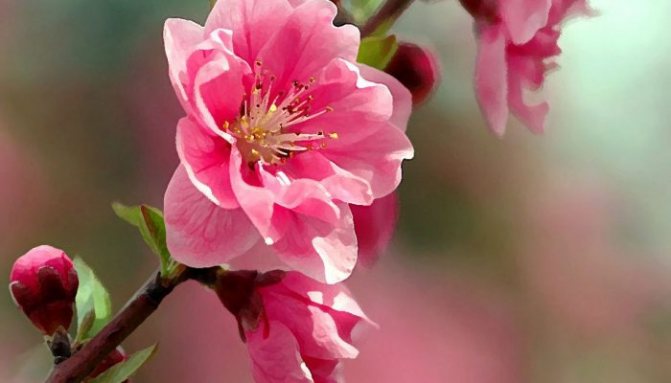

Petals of sakura can be different colors: white sakura and pink are often found, but it is not uncommon to see flowers of red, crimson, yellow and even green and mottled colors. Since the blossoms bloom before the leaves even appear on the tree, it seems as if a huge number of delicate inflorescences clung to the dead and bare trunk (so the flowering period in Japan is also associated with rebirth).
When the petals begin to fade but have not yet fallen from the tree, and the sakura sprig grows the first leaves, the plant looks extremely smart and summery (the Japanese call it Ha-Zakura, which means "sakura with leaves").
Few trees of this species bear fruit, and if they do, the fruits of sakura (sakurambo) are usually very small, cherry-colored, have a large pit, tightly wrapped in thin flesh, and taste very sour and tart. They are sold in small boxes and are extremely expensive.
Flowering time
Cherry blossoms begin in January on Okinawa Island (located in the south) and end on Hokkaido, thus moving northward. The blooming period depends a lot on the species: some plants start blooming in winter and others in late spring. For example, well-known species such as:
- Fuyu-Zakura - blooms in the last month of fall;
- Yama-zakura is an early plant, blooming in late March;
- Someyoshino in early April;
- Yae-zakura in mid-spring;
- Kasumi-zakura in the first days of May.
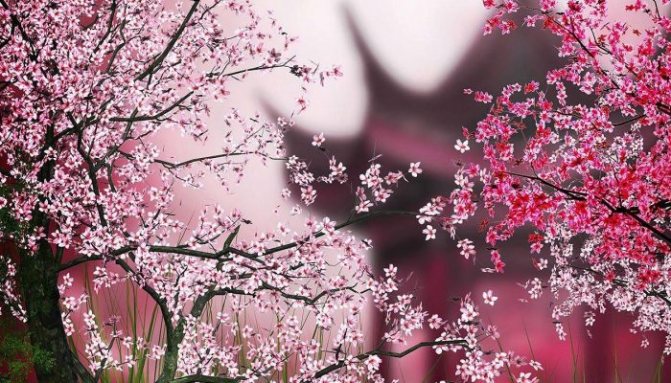

When the flower opens fully, it stays that way for about a week. How long it will bloom depends largely on the weather and temperature - the colder it is, the longer it will be possible to contemplate cherry blossoms. Strong winds and rain, on the contrary, will significantly reduce the flowering of the cherry.
Hanami Festival
Japan celebrates cherry blossoms on a national level: the official opening of Hanami ("contemplation of flowers") takes place in Tokyo's main park Shinjuku, with not only famous politicians but also members of the imperial family taking part in the event.
During this period, numerous gardens, parks, squares and other places where cherry blossoms are in bloom are visited by huge numbers of people, especially popular at night, when the cherry blossoms are beautifully illuminated. Contemplating, people have picnics, relax, and often use the Hanami holiday for personal gain - to negotiate, strengthen contacts, and make new acquaintances.
Using the tree in everyday life
The Japanese make sour wine from the fruit of the plant, or add it to rice during cooking. They also found a use for its leaves and petals - they pickle them, after which the leaves are used as an edible cover for sakura-mochi sweets made of rice, and sakura petals are quite good as a fragrant spice. During the holidays, they are often dipped in boiling water or green tea, in contact with hot water, sakura petals open and delight guests with their appearance.
Bonsai
Specialists consider the sakura ideal for bonsai trees - it grows slowly, so having bought a young plant, you can not fear that after a year or two it will have to be transplanted outdoors, especially since the vertical growth of the tree will be held back by constant pruning of new shoots and root pruning.
You can buy such a plant in special stores. Looks small flowering sakura the same as a more mature tree, only the diameter of its inflorescences does not exceed one centimeter (usually pink). When making bonsai it is necessary to remember that this plant even though small, but alive, but not a stone insensitive toy, so if you do not give it enough attention or use the wrong approach, it can die.
Bonsai pots should be shallow, and its diameter should be between 15 and 20 cm. Bonsai sakura prefer to grow on well fertilized soil. Organic fertilizers are desirable to apply to the soil a month before planting, nitrogen - simultaneously with planting, potassium and phosphorus, which promote the circulation of useful substances in the plant - in the summer. If the soil is fertilized weakly, the amount of humus should be from 8 to 12 g/dm3, and in the medium fertilized - about five.


Japanese sakura is very fond of good light, and therefore must necessarily be in a bright place (if it will stand in the shade, there is a risk of powdery mildew). Looking for a place for the plant, it should be borne in mind that it very much does not like drafts.
Water the bonsai tree once a day (half a glass of water), in winter - less often. Repot the small plant every year, cutting off 1/3 of the rhizome (branches can also, but do not get carried away, because the sakura does not like it). If you find caterpillars, woodlice, red mites, bark beetles and aphids in the soil, you must immediately destroy them with insecticides, otherwise they will very quickly destroy the plant.
Secrets of Japanese massage for two


The main piquancy of "Cherry branch" massage is that here to the excitement of touching the body, added to no less tempting touch of the lips, tongue with playful nibbling. A woman using her whole body relaxes her partner, accompanying the game with bright feelings and emotions that a man will remember for a long time.
After learning the technique of "Cherry branch" massage, a girl learns how to feel a man, to guess his desires and to give an unforgettable delight with positive feelings.
To create the conditions for pleasant emotions and sensations:
- To choose a special approach to the partner;
- think of original touches that evoke pleasant moments;
- kiss the body warmly and tenderly;
- create a suitable, disposing environment for intimacy;
- Accompany the massage with the inclusion of pleasant soft music.
Observance of small rules will help a man to enjoy new tender sensations, get positive energy, and most importantly, move to another, more intimate level of relationship.
Sakura
The most beloved flowers of the Japanese.
The sakura is a tree in the Plum subfamily of the Rosaceae family. Flower colors range from snow-white to scarlet and scarlet. Legislation in Japan does not define "state flower," but the sakura is so firmly embedded in Japanese culture that it can be considered a symbol of Japan, along with the chrysanthemum.
There are more than 600 varieties of sakura in Japan, if you count native and hybrid varieties. The most common are somei yoshino
with five-petaled pale pink flowers, bred in the middle of the Edo period (1603-1868) and spread throughout the country since the Meiji period (1869-1912).
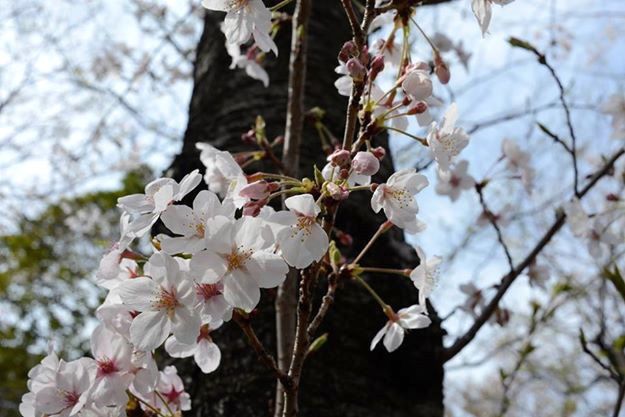

Sakura somei yoshino
The Japanese cherry tree occupies such an important place in Japanese culture that the word "flower" is often used in literature as a synonym for the word "sakura", dating back to the Heian period (794-1192). Spring picnics with relatives, colleagues, and acquaintances under the blooming sakura are an essential attribute of spring in Japan. In all regions of Japan there are places known for the beauty of the sakura blossoms there, and even some individual sakura trees are famous throughout the country. Such, for example, is the very old "Sakura of the Age of the Gods" (Jindaizakura
) in Yamanashi Prefecture, which is about 2,000 years old, or the "Sakura Waterfall in Miharu" (
Miharu-takizakura
), which is more than 1,000 years old, in Fukushima Prefecture.
Cherry blossoms are also closely associated with new encounters and partings, and with the turning points of human life. The fiscal and school year in Japan begins on April 1, the date on which the cherry blossoms in Kanto and the more western regions (usually from the last decade of March to mid-April). That's when school graduation events take place, it's the period for applying to school and work, and those who pass their entrance exams are said to have "blossomed sakura".
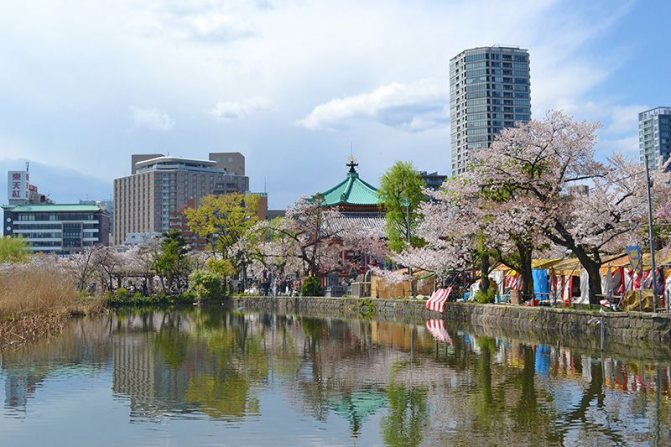

Ueno Park in Tokyo while admiring the cherry trees
Sakura in Japanese cuisine
The sakura is not only admired. The wood, flowers, leaves, and fruits of the sakura are used in the household. The fruits of some varieties are consumed as food. The soft flowers of some varieties... oshimazakura
и
Yaedzakura
are salted and then used to make sweets or other dishes.
Pickled sakura flowers, if thrown into hot water, take on their former shape as if they were blooming anew, and therefore have a benevolent meaning and drink from them, sakurai
are a favorite treat during dates that are arranged for the purpose of marriage (
o-miai
), or at weddings. They are also used to decorate bread or cookies, and are cooked with rice to flavor it.
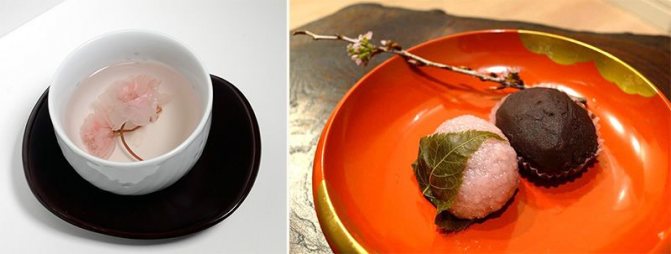

Sakuraiyu, a drink made from sakura flowers (left) Pink sakuramochi rice cakes made from sticky rice and botamochi made from a mixture of sticky and regular rice (right)
Sakura in Japanese culture
Sakura is first mentioned in the Annals of Japan, a chronicle-mythological corpus (Nihon shoki
), completed in 720. It tells how the flower fell into a cup of sake held by Emperor Ritu, who lived in the 5th century. In later literature there are many works in which the sakura appears. They are not just about the beauty of flowers and picnics
hanami
and "admiring the flowers" under the blossoming trees. The cherry blossoms are likened to the exquisite features of beautiful women, reverence for the sakura that blooms so briefly and then crumbles overnight, a courageous acceptance of one's destiny, and an example of the impermanence and frailty of existence. Thus the sakura has become a symbol of the fleeting beauty of the transient, and has had a certain influence on the formation of ideas about life and death.
The Japanese love of the sakura has survived the post-war reforms and is now also manifested in music. One of the most famous songs, a kind of "calling card" of Japan, is called "Sakura, Sakura", and in general the number of songs that contain the word in the title has exceeded a hundred; it is impossible to count the songs in the lyrics of which the sakura is mentioned.
Salon of erotic massage Pandora in Moscow
Moscow, Zvezdny Boulevard, 1 | round the clock | metro VDNH, Alekseevskaya Botanical Garden


Choose these programs:
- "Sakura branch".
- 2 erotic + 1 classic, "Sakura branch", aquapenic, shower with a girl. The 3rd level of revelation of touch (caresses). 1 hour, 9000 rubles. - "Relax"
- erotic + classical, body massage, "Sakura branch", shower with a girl before and after the program. The 3rd level of revelation of touch (caresses). 1 hour, 5500 rubles.
In the salon of erotic massage "Pandora" know how to bring joy: our girls are appetizing, the program is intense. Remember, we work around the clock - come at any time.
Sakura
Japan's most beloved flower
The sakura is a tree in the subfamily Plum family of Rosaceae. Flower colors range from snow-white to purple and scarlet. Legislation in Japan does not define "state flower," but the sakura is so firmly embedded in Japanese culture that it can be considered a symbol of Japan, along with the chrysanthemum.
There are more than 600 varieties of sakura in Japan, if you count native and hybrid varieties. The most common is somei yoshino
with five-petaled pale pink flowers, bred in the middle of the Edo period (1603-1868) and spread throughout the country since the Meiji period (1869-1912).
Sakura somei yoshino variety
The Japanese cherry has such an important place in Japanese culture that the word "flower" has often been used in literature as a synonym for the word "sakura," dating as far back as the Heian period (794-1192). Spring picnics with relatives, colleagues, and acquaintances under the blooming sakura are an essential attribute of spring in Japan. In all regions of Japan there are places known for the beauty of the sakura blossoms there, and even some individual sakura trees are famous throughout the country. Such, for example, is the very old "Sakura of the Age of the Gods" (Jindaizakura
) in Yamanashi Prefecture, which is about 2,000 years old, or the "Sakura Waterfall in Miharu" (
Miharu-takizakura
), which is more than 1,000 years old, in Fukushima Prefecture.
Cherry blossoms are also closely associated with new encounters and partings, the turning points of human life. The financial and school year in Japan begins on April 1, and this date falls on the time when the sakura blossoms in Kanto and the more western regions (usually from the last decade of March to mid-April). This is when school graduation events take place, this is the period for entering school and working, and those who pass their entrance exams are said to have "blossomed sakura".
Ueno Park in Tokyo while admiring the cherry trees
Sakura in Japanese cuisine
The sakura is not only admired. The wood, flowers, leaves, and fruits of the sakura are used in the household. The fruits of some varieties are consumed as food. The soft flowers of some varieties... oshimazakura
и
Yaedzakura
are salted and then used to make sweets or other dishes.
Pickled sakura flowers, if thrown in hot water, take on their former shape as if to blossom anew, and therefore have a benevolent meaning and drink from them, sakuraju
is a favorite refreshment on dates that are arranged for the purpose of marriage (
o-miai
), or at weddings. They are also used to decorate bread or cookies and are cooked with rice to flavor it.
Sakuraiyu, a drink made from sakura flowers (left) Pink sakuramochi rice cakes made from sticky rice and botamochi made from a mixture of sticky and regular rice (right)
Sakura in Japanese culture
Sakura is first mentioned in the Annals of Japan (Nihon shoki
), completed in 720. It tells how the flower fell into a cup of sake held by Emperor Ritu, who lived in the fifth century. In later literature, there are many works that feature sakura trees. It's not just about the beauty of flowers and picnics.
hanami
and "admiring the flowers" under the blossoming trees. They liken the cherry blossoms to the exquisite features of beautiful women, pay homage to the cherry blossoms that bloom so briefly and then crumble overnight, see them as courageous acceptance of their fate and cite them as an example of impermanence and the frailty of existence. Thus the sakura has become a symbol of the fleeting beauty of the transient, and has had a certain influence on the formation of ideas about life and death.
The Japanese love of the sakura has survived the post-war reforms and is now also manifested in music. One of the most famous songs, a kind of "calling card" of Japan, is called "Sakura, Sakura," and in general the number of songs that contain this word in the title has exceeded a hundred; songs whose lyrics mention the sakura cannot be counted.
Sources: https://geo-storm.ru/vechnye-voprosy/pochemu/pochemu-sakura-simvol-japonii/ https://www.kakprosto.ru/kak-889521-pochemu-sakura-yavlyaetsya-simvolom-yaponii https://www.astrostar.ru/articles/drevnie-kultury/yaponiya/sakura-simvol-yaponii.html https://awesomeworld.ru/zhivaya-priroda/mir-rastenij/sakura-simvol-yaponii.html https://www.nippon.com/ru/features/jg00011/ https://www.nippon.com/ru/features/jg00011/ https://www.koolinar.ru/recipe/view/49680
